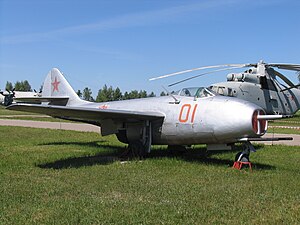MiG-9
| MiG-9 | |
|---|---|
 |
|
| Red 01 at the Central Air Force Museum, Monino, Russia | |
| Role | Fighter |
| Manufacturer | Mikoyan-Gurevich |
| First flight | 24 April 1946 |
| Status | Retired |
| Primary users |
Soviet Air Forces PLA Air Force |
| Produced | 1946–1948 |
| Number built | 610 (including prototypes) |
The Mikoyan-Gurevich MiG-9 (Russian: Микоян и Гуревич МиГ-9, USAF/DOD designation Type 1, NATO reporting name: Fargo) was the first turbojet fighter developed by Mikoyan-Gurevich in the years immediately after World War II. It used reverse-engineered German BMW 003 engines. Categorized as a first generation jet fighter, it was moderately successful, but suffered from persistent problems with engine flameouts when firing its guns at high altitudes due to gun gas ingestion. A number of different armament configurations were tested, but nothing solved the problem. Several different engines were evaluated, but none were flown as the prototype of the MiG-15 promised superior performance.
A total of 610 aircraft were built, including prototypes, and they entered service in 1948 with the Soviet Air Forces. At least 372 were transferred to the People's Liberation Army Air Force in 1950 to defend Chinese cities against air raids by the Nationalist Chinese and train the Chinese pilots in jet operations. The MiG-9 was quickly replaced by the MiG-15, and three are known to survive.
In February 1945, the Council of People's Commissars ordered the Mikoyan-Gurevich (MiG) OKB to develop a single-seat jet fighter to be equipped with two German BMW 003 engines. Intended to destroy bombers, the aircraft was to be equipped with a single 57-millimeter (2.2 in) or 37-millimeter (1.5 in) gun, plus two 23-millimeter (0.9 in) guns. A more detailed directive was issued on 9 April setting out requirements that the aircraft should have a maximum speed of 900 kilometers per hour (559 mph) at sea level and a speed of 910 km/h (565 mph) at an altitude of 5,000 meters (16,400 ft). It should be able to climb to that altitude in four minutes or less and it should have a maximum range of 820 kilometers (510 mi). Three prototypes were ordered to be ready for flight tests by 15 March 1946.
...
Wikipedia
